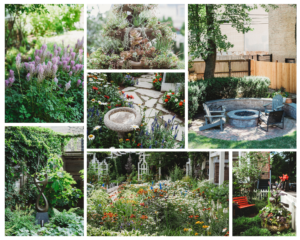If you’re less than overjoyed with your home’s outdoor space, here’s a concept that may help you begin to envision a new possibility for it: genus loci.
It translates to “the spirit of a place” and refers to the unique atmosphere, character, and distinctiveness of a particular location.
Genus loci is woven into how we approach design and build projects. Our goal is to meet each client’s desires for their space in a way that considers—and works with—the natural and built environment.
You may need to overcome challenges in your space like drainage issues or lack of privacy. You may also want a cozy spot where you can curl up with a book while the kids play outside, herbs growing close to the kitchen, and a nook where you can gather around a fire with your favorite people for a nightcap.
Address these goals generically and you can end up with a space that looks out of place and feels off-putting. Make the environment an inherent element of your design, and you end up with space that naturally draws you in.

Here are 10 genius loci considerations to keep in mind when designing an outdoor landscape:
- Natural Elements: Selecting native plants that thrive in the local climate and soil conditions not only ensures a sustainable landscape but also connects the backyard to the surrounding natural environment. Also, designing the landscape to showcase the beauty of changing seasons, such as vibrant autumn foliage or blooming spring flowers, embraces the local climate and adds a temporal dimension to the backyard.
- Architectural Harmony: Choosing hardscape materials, such as patio stones or fencing that complement the architectural style of the home and other structures in the neighborhood maintains visual harmony and a sense of continuity.
- Outdoor Living Spaces: Creating outdoor living spaces that reflect the lifestyle of the homeowners while respecting the scale and proportions of the neighborhood.
- Cultural Connection: Incorporating local art or craftsmanship, such as sculptures or handmade furniture by local artisans, adds a cultural touch to the backyard and strengthens the connection to the community.
- Vintage Design Elements: Incorporating vintage or reclaimed design elements, such as antique garden furniture or architectural salvage, can evoke a sense of history.
- Sustainability: Implementing sustainable practices like rainwater harvesting systems aligns with the environmental consciousness of the region and contributes positively to the backyard’s functionality. Using permeable surfaces for pathways and driveways helps manage water runoff and supports the local ecosystem.
- Social Spaces: Designing spaces that encourage social interactions, such as a communal fire pit or a cozy seating area, promotes a sense of community and neighborly connection.
- Wildlife Habitat: Including pollinator-friendly plants to attract local wildlife, such as bees and butterflies, creates a backyard ecosystem that supports biodiversity and reflects the natural surroundings.
- Personal Touch: Incorporating elements that reflect the family’s heritage, such as a small herb garden with culinary herbs from the family’s cultural background, adds a personal touch to the backyard.
- Historical References: Introducing plant varieties that have historical significance in the region or were traditionally used in local gardens establishes a link to the area’s horticultural heritage.
By carefully factoring genius loci into planning, the design of an outdoor space becomes a reflection of the local environment, culture, and history, creating a place that feels harmonious, rooted, and inviting.
Are you ready to transform your outdoor space into one where you love spending time? Send us a message to find out how we may be able to help.